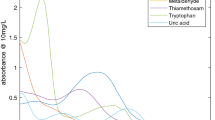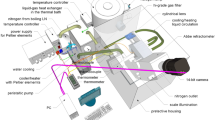Abstract
WE have measured the absorption of light in cæsium vapour, by photographic photometry, from the series limit (λ 3184 A.) to λ 1935 A. The absorption cell was a quartz tube two metres in length. The vapour was superheated to about 270° C. and the vapour pressure was varied from 0.15 mm. to 0.6 mm.
This is a preview of subscription content, access via your institution
Access options
Subscribe to this journal
Receive 51 print issues and online access
$199.00 per year
only $3.90 per issue
Buy this article
- Purchase on Springer Link
- Instant access to full article PDF
Prices may be subject to local taxes which are calculated during checkout
Similar content being viewed by others
References
Mohler and Boeckner, Research Paper No. 96, U.S.A. Bureau of Standards.
Little, Phys. Rev., 30, 109; 1927.
Lawrence and Edelfsen, Phys. Rev., 34, 233; 1929.
Cooke, Phys. Rev., 38, 1351; 1931.
This value is based on a cæsium vapour pressure derived from the formula given by Mohler and Boeckner (loc. cit., p. 307)
Author information
Authors and Affiliations
Rights and permissions
About this article
Cite this article
BRADDICK, H., DITCHBURN, R. Absorption of Light in Cæsium Vapour. Nature 131, 132–133 (1933). https://doi.org/10.1038/131132c0
Issue Date:
DOI: https://doi.org/10.1038/131132c0
Comments
By submitting a comment you agree to abide by our Terms and Community Guidelines. If you find something abusive or that does not comply with our terms or guidelines please flag it as inappropriate.



